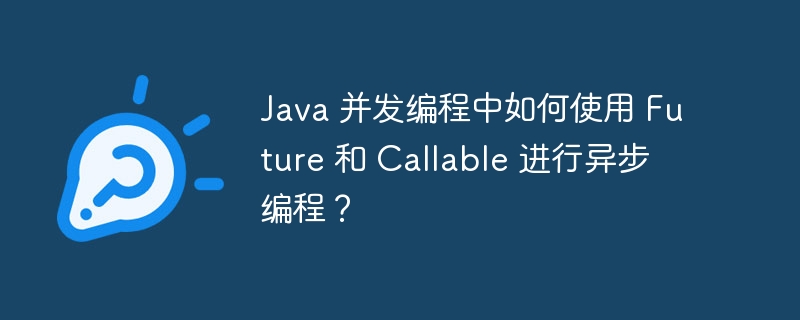Home >Java >javaTutorial >How to use Future and Callable for asynchronous programming in Java concurrent programming?
How to use Future and Callable for asynchronous programming in Java concurrent programming?
- 王林Original
- 2024-05-08 10:39:02784browse
Use Future and Callable for Java asynchronous programming: Future encapsulates the results of asynchronous operations and obtains the return value through the get() method. Callable is used to create asynchronous tasks, similar to Runnable but can return a value. In the example, a Callable task is created and submitted to the executor service for asynchronous execution. The main thread continues to perform other tasks, and when the results are needed, call Future.get() to obtain them. Finally shut down the executor service to release resources.

Using Future and Callable for asynchronous programming in Java concurrent programming
Introduction
Asynchronous programming is a technology that allows tasks to be executed concurrently without blocking the main thread. In Java, asynchronous programming can be implemented using Future and Callable interfaces.
Future
Future is the result encapsulation of an asynchronous operation. It is used to get the return value of a task, even if the task has not yet completed. Future provides the get() method, which will return the result when the task is completed.
Callable
Callable is an interface for creating asynchronous tasks. It is similar to the Runnable interface, but Callable can return a value, while Runnable can only perform one operation.
Asynchronous Programming Example
Here is an example of asynchronous programming using Future and Callable:
import java.util.concurrent.*;
public class AsyncExample {
public static void main(String[] args) {
ExecutorService executorService = Executors.newSingleThreadExecutor();
// 创建 Callable 任务,它将执行一个耗时的操作并返回结果
Callable<Integer> task = () -> {
// 模拟耗时的任务
Thread.sleep(1000);
return 42;
};
// 将 Callable 任务提交到执行器服务,它将异步执行任务
Future<Integer> future = executorService.submit(task);
// 主线程可以继续执行其他任务,而不必等待 Callable 任务完成
System.out.println("Main thread is doing other work.");
// 当需要结果时,可以调用 Future 的 get() 方法来获取它
try {
// 等待任务完成并获取结果
Integer result = future.get();
System.out.println("Result: " + result);
} catch (InterruptedException | ExecutionException e) {
// 处理任务中断或执行异常
e.printStackTrace();
} finally {
// 关闭执行器服务以释放资源
executorService.shutdown();
}
}
}In this example:
-
taskis a Callable task that performs a time-consuming operation and returns the result. -
futureis a Future that encapsulates the result of the Callable task. -
executorServiceis an executor service, which is used to execute Callable tasks asynchronously. - The main thread can continue to perform other tasks after submitting the task without waiting for the task to be completed.
- When the result is needed, the main thread can call the
future.get()method to obtain it.
The above is the detailed content of How to use Future and Callable for asynchronous programming in Java concurrent programming?. For more information, please follow other related articles on the PHP Chinese website!
Related articles
See more- Introduction to Java High Concurrency Architecture Design (Pictures and Text)
- What is the difference between c language and java
- What are the three solutions to high concurrency?
- How to prevent product inventory from being oversold under high concurrency conditions in PHP
- How to convert string to array in javascript

